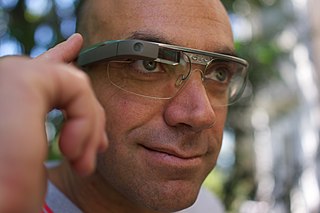
Augmented reality (AR) is an interactive experience of a real-world environment where the objects that reside in the real world are enhanced by computer-generated perceptual information, sometimes across multiple sensory modalities, including visual, auditory, haptic, somatosensory and olfactory. AR can be defined as a system that incorporates three basic features: a combination of real and virtual worlds, real-time interaction, and accurate 3D registration of virtual and real objects. The overlaid sensory information can be constructive, or destructive. This experience is seamlessly interwoven with the physical world such that it is perceived as an immersive aspect of the real environment. In this way, augmented reality alters one's ongoing perception of a real-world environment, whereas virtual reality completely replaces the user's real-world environment with a simulated one. Augmented reality is related to two largely synonymous terms: mixed reality and computer-mediated reality.

Mixed reality (MR) or polyplexity is the merging of real and virtual worlds to produce new environments and visualizations, where physical and digital objects co-exist and interact in real time. Mixed reality does not exclusively take place in either the physical world or virtual world, but is a hybrid of augmented reality and virtual reality. To mark the difference: Augmented reality takes place in the physical world, with information or objects added virtually like an overlay; Virtual Reality immerged you in a fully virtual world without the intervention of the physical world.
Wireless Application Protocol (WAP) is a technical standard for accessing information over a mobile wireless network. A WAP browser is a web browser for mobile devices such as mobile phones that use the protocol. Introduced in 1999, WAP achieved some popularity in the early 2000s, but by the 2010s it had been largely superseded by more modern standards. Almost all modern handset internet browsers now fully support HTML, so they do not need to use WAP markup for web page compatibility, and therefore, most are no longer able to render and display pages written in WML, WAP's markup language.

HERE Technologies is a multinational group dealing with mapping, location data and related automotive services to individuals and companies. It is majority-owned by a consortium of German automotive companies and American semiconductor company Intel whilst other companies also own minority stakes. Its roots date back to U.S.-based Navteq in 1985, which was acquired by Finland-based Nokia in 2007. HERE is currently based in The Netherlands.

Wikitude is a mobile augmented reality (AR) technology provider based in Salzburg, Austria. Founded in 2008, Wikitude initially focused on providing location-based augmented reality experiences through the Wikitude World Browser App. In 2012, the company restructured its proposition by launching the Wikitude SDK, a development framework utilizing image recognition and tracking, and geolocation technologies.
Nokia Point & Find is a mobile application, which lets you point your Nokia smartphone camera at objects and images you want to know more about, to find more information. It is a visual search technology that uses the phone's camera to obtain information by using image recognition to identify objects, images and places in the physical world in real-time. For example, one can use the application to find information on movies by pointing the camera at movie posters and then view reviews, or find tickets at nearby theaters. Its uses include city landmark tagging, barcode scanning for comparison shopping and 2D barcode scanning and finding information related to products and services based on content provided by third party publishers.

Word Lens was an augmented reality translation application from Quest Visual. Word Lens used the built-in cameras on smartphones and similar devices to quickly scan and identify foreign text, and then translated and displayed the words in another language on the device's display. The words were displayed in the original context on the original background, and the translation was performed in real-time without a connection to the internet. For example, using the viewfinder of a camera to show a shop sign on a smartphone's display would result in a real-time image of the shop sign being displayed, but the words shown on the sign would be the translated words instead of the original foreign words.
Vuzix is an American multinational technology firm headquartered in Rochester, New York. Founded in 1997 by Paul Travers, Vuzix is a supplier of wearable display technology, virtual reality and augmented reality. Vuzix manufactures and sells computer display devices and software. Vuzix personal display devices are used for mobile and immersive augmented reality applications, such as 3D gaming, manufacturing training, and military tactical equipment. On January 5, 2015, Intel acquired 30% of Vuzix's stock for $24.8 million.

Recon Instruments was a Canadian technology company that produced smartglasses and wearable displays marketed by the company as "heads-up displays" for sports. Recon's products delivered live activity metrics, GPS maps, and notifications directly to the user's eye. Recon's first heads-up display offering was released commercially in October 2010, roughly a year and a half before Google introduced Google Glass.
Metaio was a privately held Augmented Reality (AR) company that developed software technology and provided augmented reality solutions. Headquartered in Munich, Germany, with subsidiaries in San Francisco, California, New York City, New York and Dallas, Texas, Metaio provided a software development kit (SDK) for programming PC, web, mobile and custom offline augmented reality applications. Additionally, Metaio was the creator of Junaio, a free mobile AR browser available for Android and iOS devices. On 28 May 2015 it was reported that Metaio GmbH was acquired by Apple Inc for an undisclosed sum.
Microsoft mobile services are a set of proprietary mobile services created specifically for mobile devices, they are typically offered through mobile applications and mobile browser for Windows Phone, | platforms, BREW, and Java. Microsoft's mobile services are typically connected with a Microsoft account and often come preinstalled on Microsoft's own mobile operating systems while they are offered via various means for other platforms. Microsoft started to develop for mobile computing platforms with the launch of Windows CE in 1996 and later added Microsoft's Pocket Office suite to their Handheld PC line of PDAs in April 2000. From December 2014 to June 2015, Microsoft made a number of corporate acquisitions, buying several of the top applications listed in Google Play and the App Store including Acompli, Sunrise Calendar, Datazen, Wunderlist, Echo Notification Lockscreen, and MileIQ.
Merchlar is an augmented reality (AR) company based in Montreal, NYC and Paris. It develops mobile applications using AR and VR technology for clients, including: Desjardins Group, Ubisoft, and Mohegan Sun. In addition to its agency, Merchlar has an R&D department that creates patented AR technology.

Far-Play is a software platform developed at the University of Alberta, for creating location-based, scavenger-hunt style games which use the GPS and web-connectivity features of a player's smartphone. According to the development team, "our long-term objective is to develop a general framework that supports the implementation of AARGs that are fun to play and also educational". It utilizes Layar, an augmented reality smartphone application, QR codes located at particular real-world sites, or a phone's web browser, to facilitate games which require players to be in close physical proximity to predefined "nodes". A node, referred to by the developers as a Virtual Point of Interest (vPOI), is a point in space defined by a set of map coordinates; fAR-Play uses the GPS function of a player's smartphone—or, for indoor games, which are not easily tracked by GPS satellites, specially-created QR codes—to confirm that they are adequately near a given node. Once a player is within a node's proximity, Layar's various augmented reality features can be utilized to display a range of extra content overlaid upon the physical play-space or launch another application for extra functionality.

Tango was an augmented reality computing platform, developed and authored by the Advanced Technology and Projects (ATAP), a skunkworks division of Google. It used computer vision to enable mobile devices, such as smartphones and tablets, to detect their position relative to the world around them without using GPS or other external signals. This allowed application developers to create user experiences that include indoor navigation, 3D mapping, physical space measurement, environmental recognition, augmented reality, and windows into a virtual world.

Smartglasses or smart glasses are wearable computer glasses that add information alongside or to what the wearer sees. Alternatively, smartglasses are sometimes defined as wearable computer glasses that are able to change their optical properties at runtime. Smart sunglasses which are programmed to change tint by electronic means are an example of the latter type of smartglasses.

Windows Mixed Reality is a platform introduced as part of the Windows 10 operating system, which provides augmented reality and mixed reality experiences with compatible head-mounted displays.

Microsoft HoloLens, known under development as Project Baraboo, are a pair of mixed reality smartglasses developed and manufactured by Microsoft. HoloLens was the first head-mounted display running the Windows Mixed Reality platform under the Windows 10 computer operating system. The tracking technology used in HoloLens can trace its lineage to Kinect, an add-on for Microsoft's Xbox game console that was introduced in 2010.
Everysight Ltd. is an Israeli technology company established in 2014 as a spinoff of Elbit Systems. Everysight develops smartglasses based on augmented reality technology for the civilian market. The company's main product is Raptor smartglasses.
Commercial augmented reality (CAR) describes augmented reality (AR) applications that support various B2B (Business-to-Business) and B2C (Business-to-Consumer) commercial activities, particularly for the retail industry. The use of CAR started in 2010 with virtual dressing rooms for E-commerce.











